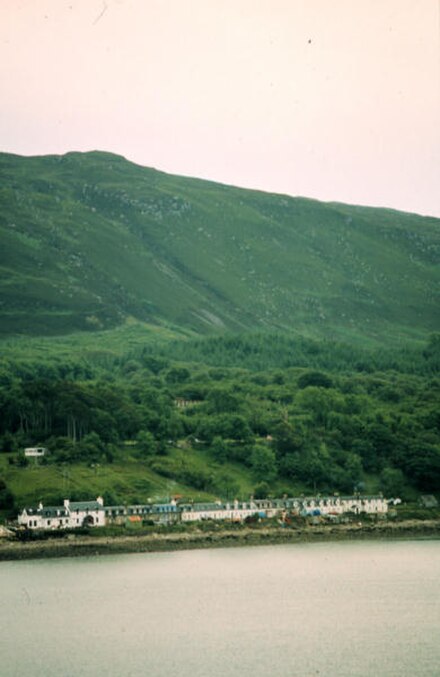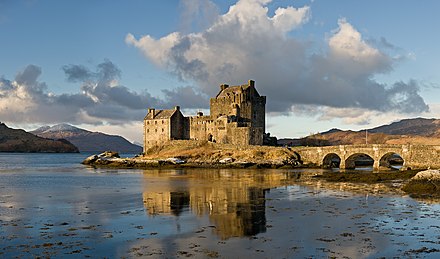Scottish Highlands - historic region of Scotland
The Scottish Highlands (Scottish Gaelic: A' Ghàidhealtachd, "the place of the Gaels") is the rugged northern and north-western portion of Scotland. This is the Scotland conjured up by visions of tartan, kilts, Bonnie Prince Charlie and all.
Regions

This is the heart of the Highlands, with Inverness 📍, the only city, a good base for visitors. In Strathspey, come to Aviemore 📍 for skiing and to explore Cairngorms National Park 📍, which crosses the mountains into Aberdeenshire. The Spey valley also produces much of Scotland's finest whisky. The Great Glen contains deep, dark Loch Ness 📍, and stretches south to Fort William 📍 at the foot of Ben Nevis 📍, Britain's highest mountain. The "Road to the Isles" runs west to Mallaig 📍.
A straggling region, dissected by the long cold fingers of sea lochs, so the roads have to wind around and double back. Just north of Glasgow is Loch Lomond 📍, and ranged over the hills above is the scenic Loch Lomond and The Trossachs National Park 📍. Inveraray 📍 is a photogenic 18th C town and castle. Oban 📍 on the west coast is the ferry port for several Hebridean islands. The Argyll peninsula stretches south to Campbeltown 📍, almost within touching distance of Northern Ireland. A short-cut by ferry is from Gourock to Dunoon 📍 on the Cowal peninsula. Other ferries link the Isle of Bute 📍.
The eastern part is low-lying and fertile, with the scenic peninsula of The Black Isle 📍 just over the bridge from Inverness. The west has dramatic scenery, with sharp Alp-like mountains. Ullapool 📍 is the ferry port for Stornoway on Lewis.
A sparsely populated area of moorland; Dunrobin Castle is in the village of Golspie. The most northerly parts, towards Thurso 📍 and Wick, were historically Norse rather than Gaelic.
Understand

Talk
English is predominant everywhere in the Scottish Highlands. Scottish Gaelic is spoken by a small minority of locals, especially in the west, but all of them speak English as well. Some road signs are bilingual, but Gaelic is less obvious here than Skye and the Outer Hebrides.
Get in
By plane
For Argyle & Bute use Glasgow Airport 📍 (IATA: GLA), which has good domestic connections and direct flights across Europe. Glasgow has daily flights to Campbeltown, Wick, the Hebrides, Orkney and Shetland. The airport is west of the city so you drive onto the M8 then cross Erskine Bridge northbound, without getting snarled in the centre.
Further north, it's equally convenient to use Glasgow or Edinburgh Airport, which likewise has excellent connections and is west (hence clear) of that city. But the closest is Inverness Airport (IATA: INV), with international flights from Amsterdam, Dublin and Düsseldorf, and UK flights from London LHR, Manchester, Kirkwall (Orkney), Sumburgh (Shetland) and Stornoway (Lewis).
By rail
Scotrail trains run every couple of hours from Glasgow and Edinburgh via Perth and Aviemore to Inverness. Change at Inverness for trains west to Kyle of Lochalsh (for Skye), north to Wick and Thurso (for Orkney) and east towards Aberdeen.
Trains also run from Glasgow up the West Highland Railway via Arrochar (for Loch Lomond) and Crianlarich, where the train divides for Oban (for Mull, Coll, Tiree and Colonsay), or for Fort William and Mallaig (for Skye and the Small Isles).
Travelling from England usually means changing in Edinburgh or Glasgow (and maybe changing stations there), but there is one direct train per day from London Kings Cross via Edinburgh to Inverness.
The overnight Caledonian Sleeper runs from London Euston to Edinburgh, Glasgow, Aberdeen, Inverness and Fort William. Sleeping berths and saloon seats are available, reservations are compulsory, and you need to be in the correct portion of the train as it divides in the small hours. It also serves intermediate stations such as Preston, Perth and Arrochar, but at inconvenient hours.
By bus
Scottish Citylink offers a relatively frequent service to many parts of the Highlands from Glasgow, Perth and Inverness.
West Coast Motors offers bus services throughout the Argyll and Bute region as well as buses from Glasgow to Campbeltown and Oban.
Stagecoach offers services across the Highlands.
National Express and Megabus run buses from England.
By car
There are numerous roads from the Central Scotland region into the Scottish Highlands. One of the most scenic involves the drive along Loch Lomond, out to Oban then north to Fort William and along Loch Ness to Inverness.
Inverness can be reached from the south by the A9 from the south (Perth & M90 from Edinburgh, Glasgow) and from Aberdeen, 110 miles by the A96 road. The A82 reaches Inverness from the south-west, Loch Ness, Fort William and eventually to Skye. None of the roads to Inverness are entirely dual-carriageway. The A9 continues to Thurso on the extreme north coast of the Scottish mainland.
Get around
Scottish Citylink, West Coast Motors and Stagecoach should help to get you moving around the region if you are not in a car. Air service means connections in Glasgow while there are only a few train lines through the region, notably the West Highland Railway. There are two scenic lines: to Thurso and Wick, and to Kyle of Lochalsh.
By car
Many of the roads, especially in the more remote areas of the North West are single track with passing places. Driving there is a pleasure.
The North Coast 500 is a 500 mile circuit around the coast of Caithness and Sutherland and Ross and Cromarty.
By thumb
Hitchhiking is a good way to get around in the Highlands, with up to one in ten cars stopping for hitchhikers, but has two significant downsides. First, the road network is quite sparse in places. Also, many of the country roads that do exist have very low traffic density.
See

- Eilean Donan Castle, Dornie - is one of the most recognized castles in the world. It has appeared in many films including Highlander and the James Bond film The World Is Not Enough.
- Dunrobin Castle, Golspie - Gorgeous castle with fantastic exterior, gardens and falconry demonstrations M-Sa 11AM and 2PM. About an hour and a half north of Inverness. Adults £8, children £5, OAPs and students £7 for castle and gardens.
- Applecross - See the views from Scotland's highest mountain road on the way to Applecross at about 2000 ft! Isolated peninsula known for its rugged beauty. Seal trips with Calum's at Plockton guarantees seals on your excursion or your money back. Not far from Kyle of Lochalsh area.
- Inverewe Gardens, near Gairloch - Lovely National Trust For Scotland garden, an hour north of Kyle of Lochalsh. Wonderful NTS Gardens that take full advantage of the Gulf Stream to grow tropical plants at this very un-tropical latitude.
- Cape Wrath, north-west of Durness - the extreme north-west point of Scotland. It can be reached either by a long walk or by a ferry followed by a minibus along a road unconnected with any other.
- Loch Maree (correct spelling), between Gairloch and Torridon - possibly the finest inland loch in the Scottish mainland, surrounded by peaks of Torridonian Sandstone.
- Sandwood Bay, near Kinlochbervie - reckoned by Undiscovered Scotland to be the best beach in Great Britain.
Islands
- The Summer Isles - an archipelago of small islands near Achiltibuie
- Handa Island - wonderful bird reserve north of Kylestrome. Headware is advised in the breeding season as skuas are quite aggressive.
Mountains
A mountain above 3000 feet is called a Munro, and a mountain between 2500 and 3000 feet is called a Corbett.
There are far too many mountains in Scotland to cover them all here. Here are some popular mountains by group (pronunciations of difficult names in italics):
Far north
- Ben Hope
- Ben Loyal
- Foinaven
- Ben Stack - neither particularly high nor well known but a little gem.
Northern Torridonian mountains
Mountains of Torridonian sandstone north of Ullapool.
- Quinag - An easy Corbett for beginners as it's possible to start well up from the main road south from Kylescu.
- Suilven - easier than it looks but its distance from roads makes it a challenge.
- Cul Mor
- Cul Beag
- Stac Pollaidh (pron. "Stack Polly") - Less than a Corbett but with an outstanding shape and rock ridge -unfortunately much eroded because of its proximity to the road.

Torridonian Munros
- An Teallach (pron. "An Tyallach") - a fairly hard ridge walk above Little Loch Broom.
- Slioch - on the 'non-road' side of Loch Maree.
- Bein Eigh - above the Loch Maree road and much of the road from Kinlochewe to Torridon.
- Liathach (pron. "Lee-a-hach") - above the village of Torridon.
- Beinn Aligin - above the minor road from Torridon to the Aligins and Lower Diabaig.
- Bein Bhann - otherwise known as the Applecross mountains.
Glencoe and Fort William
- Ben Nevis - the highest start from the distillery on the road north.
- The Mamores - a picturesque group of numerous Munros between Glen Nevis and Kinlochleven.
- Aonach Eagach (pron. "Annach Eegach") - a superb ridge above Glencoe.
- The three sisters of Glencoe - shapely peaks on the other side of the glen.
Cairngorms
A range second only in height to the Nevis range, located east of the A9. There is a railway up Cairn Gorm (which is not the highest). However you make the height, it's relatively easy to walk more peaks, with excellent views. It is the only area in the UK where wild reindeer can be seen - re-introduced from Scandinavia after becoming extinct in Scotland. Red squirrels are also to be seen in the remains of the old Caledonian Pine Forests.
- Ben Macdhui
- Braeriach
- Lairig Ghru - not a mountain but probably the most spectacular mountain pass in the UK - making a fine and well known walk.
Do

- Long-distance walks include the West Highland Way from Milngavie to Fort William, 96 miles, and the Great Glen Way from Fort William to Inverness, 73 miles.
- Climb Ben Nevis, see Fort William for routes.
- Take a steam train excursion along the West Highland Line to Glenfinnan, Arisaig and Mallaig, or along the Strathspey Railway from Aviemore to Boat of Garten.
- Ski at Glencoe or on Cairngorm above Aviemore.
- Spot dolphins and whales in the Moray Firth: regular boat trips from Inverness.
- Hike in the Torridon mountains.
- Explore Cairngorms National Park - you might spot beaver, reindeer or even a wildcat.
Eat
The eating opportunities can be more restricted away from the towns, and some places may take last orders at 8pm or even earlier, so it may be worth planning ahead where you are going to eat.
Drink
There are a few breweries and several whisky distilleries in the Highlands.
Sleep
Accommodation is scanty in relation to the number of visitors: it alternates between being full for summer holidays, and closed for winter. Schools and universities make block bookings at Easter and mid-term break. You might be able to rock up and find a place in shoulder season, but it's always best to book well ahead.
Go next
After the Highlands, the next logical place to explore are the islands: the Hebrides, the Orkney Islands, and the Shetland Islands lie to the northwest and northeast.